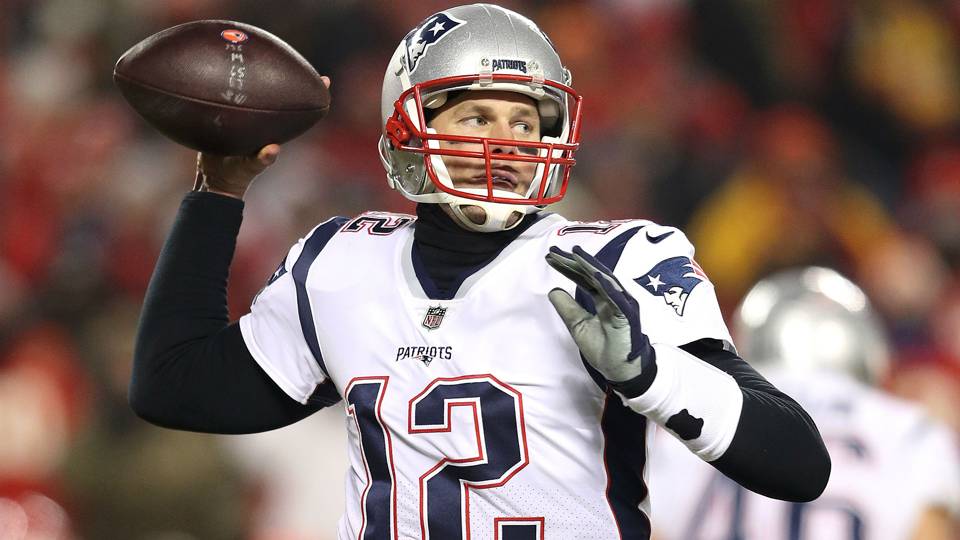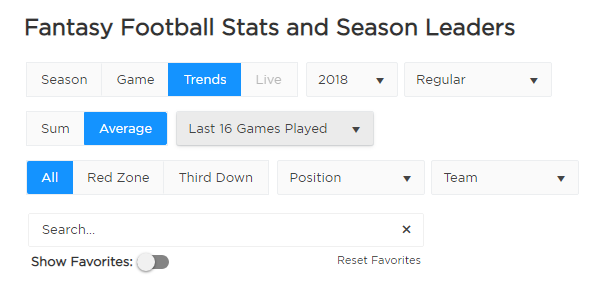“Give a man a fish and you feed him for a day. Teach him how to fish and you feed him for a lifetime.”
That quote from the Chinese philosopher Lao Tzu, founder of Taoism, perfectly illustrates the benefits of taking the time to create your own fantasy football rankings.
The talented team of writers at FantasyData are here to provide you statistical insights and trends of certain players, but we also take pride in teaching you how to become a better fantasy football player. You may be thinking I work 40 hours or more a week and don’t have time to create rankings. You may even be wondering should I even care about rankings until a few weeks before my fantasy football draft. You may be content with simply using rankings from your favorite website or whatever fantasy football rankings pop on the first page of Google. Don’t be like everyone else in your leagues that uses pre-printed cheat sheets or customized ones from a website. The dominant participants in your fantasy football league build their own and adjust them all year round. You are already spending hours a day watching ESPN, listening to podcasts, and sports radio. Why not leverage that information into creating and maintaining your own rankings? This article will provide you with 10 tips to streamline that process.
1. The Foundation

2. Batching Player and Teams Together
You’ll want to group players and teams into tiers.
There are numerous resources you could analyze in creating player tiers. ADP is useful to gain insight into how other fantasy players perceive the value of certain players. You could adjust players based on last year’s weekly and season-long production using statistics such as passing yards, rushing attempts, targets, rushing yards, and receiving yards The use of a three-year weighted average is also useful when trying to project how players will perform. It takes a series of number and assigns values to them to reflect their importance within a group of numbers. A weighted average is useful in studying trends of player production.
The techniques mentioned above can be used when analyzing team stats and rankings. You’ll want to look at statistics such as the number of plays, points scored, total yards, and time of possession. All of the stats mentioned above and more are available through FantasyData.
You could also research NFL offensive coordinator and head coaches to better understand how certain positions have performed over the years in their schemes. The Coaching History tool at statistics can help streamline that process. You’ll want to know if the player has worked in a similar offensive scheme in the past. How long does it take to learn the scheme? Running backs are most likely to get off to a fast start than wide receivers or quarterbacks.
3. Fragility
Larry Fitzgerald is back with the #Cardinals for his 16th NFL season, all in Arizona. He has been one of the most durable wide receivers of all time, missing just 6 career games (2 of those between 2008-2018).
— Inside Injuries (@InsideInjuries) January 23, 2019
Fragility is defined as the quality of being easily broken or damaged. Injuries are a part of football. Some players are physically tougher than others. Players may be upgraded or downgraded in your rankings based on their injury history. It is also important to factor in the timing of that injury. There are websites that use data analytics, statistical modeling, medical knowledge, and other resources to assign players an injury probability. This type of analysis could also be useful in better understanding how injuries affect a player’s performance on the field. Two websites that excel in this type of analysis are Sports Injury Predictor and Inside Injuries.
4. Beat Reporting
NFL Beat Writers provide you in-depth reporting of a particular all year round. There are many websites out that aggregate all of this news for you including FantasyData, Rotoworld, and Rotowire. You could take it a step further than your competition by using Google Alerts to create your own RSS feed. You can use the NFL teams, players, or beat writers as a keyword. Around the NFL Writer Chris Wesseling maintains a list on his Twitter account of Beat Writers.
You can become an NFL Insider by staying on top of the news flow. It can provide fantasy relevant insight such as running backs by committee, the impact of offensive line play, suspensions, additional opportunities players may see, and if a team’s passing or running game could change due to personnel.
5. Consistency is the Key to Fantasy Success
Per game statistics are more predictive than season-long stats. Passing yards per game is very predictive for quarterbacks. Usage and rushing yards per game are predictive for running backs. While air yards, targets, and receiving yards per game are predictive for wide receivers and tight ends. It is also useful to understand a player’s snaps played and how that could change in the future.
Coaching changes, free agency, the draft, and other factors could positively or negatively impact a player’s consistency. You will also benefit from understanding what positive or negative trends players had at different points of the season. This is a great way to uncover players who could break out or players whose production declined as the season went on. FantasyData also provides projections that you can use to tweak your rankings.
6. Change is Inevitable
Below are skill players you could have paid in 2018 with Aaron Rodgers’ $33.5M average annual value:
QB Patrick Mahomes
RB Ezekiel Elliott
RB Christian McCaffrey
RB Alvin Kamara
RB Aaron Jones
WR Julio Jones
WR Michael Thomas
WR Tyreek Hill
WR JuJu Smith-Schuster#NFLFreeAgency— NFL Research (@NFLResearch) March 8, 2019
What’s the fantasy impact of a player changing teams? Is the team stronger or weaker as a result of free agency or the draft? What about coaching changes? Is this player being promoted or demoted? Who are the projected starters? These are questions that you should ask yourself.
A player changing teams could be a good thing if the conditions are right. As an example, a No. 1 receiver has moved to a team in the same role and is expected to see the same target volume with a more efficient quarterback. This is a player that is positioned for success. If the same wide receiver is being demoted to the No. 2 receiver that’s not ideal.
Football is a team sport and it’s much easier for a Hall of a Famer caliber player to meet that potential with the right supporting cast. This is why it’s important for NFL front offices to address areas of needs. Coaching changes can provide you with insight into how the offensive or defensive schemes could change and how talent on the roster will be leveraged. You should also consider the reputation of the new coach. What is the coach’s reputation? What has the coach accomplished? Will it be a positive or a negative change?
Change isn’t a bad thing, but it must be reflected properly in your rankings.
7. The Big Uglies Matter
The Bills OL received the second-worst run blocking grade on Pro Football Focus last season. The team’s OL also ranked near the bottom in Adjusted Line Yards according to Football Outsiders over the last two seasons. pic.twitter.com/UPeHpAFWho
— Moody (@EricNMoody) February 26, 2019
Offensive line analysis is often overlooked in fantasy football analysis. Do not allow this to happen in yours. Pro Football Focus’ team of 300 plus staff grades and spends countless hours analyzing every play of the NFL season. This includes offensive line play and provides you grades into the unit and individual’s run and pass blocking.
Offensive line play has a ripple effect on the entire offense. The fewest changes at the position are ideal because the chemistry of the unit stays in intact. Poor offensive line play results in more quarterback pressures and sacks. The running game also suffers, but certain running backs like Todd Gurley or Le’Veon Bell have the athletic ability to transcend it. Think about how much more productive those players are behind great offensive line play. One way you could better understand the relationship between the offensive line and running back is by analyzing Adjusted Line Yards and Open Field Yards at Football Outsiders.
You should be aware of injuries, players holding out, retirements, and inexperience. All of these things could impact the quality of play.
8. The Best Defense is a Good Offense
It’s easy to get enamored by safeties, turnovers, and defensive touchdowns when evaluating DSTs. Those are very volatile statistics and not predictive. Points allowed, sacks and total yards per game are more predictive. The top defenses in previous seasons have a decent chance to stay at the top. Defenses influence game flow. A good one allows the offense to run more, but a bad one forces the offense to throw more. Positive or negative game script is dictated by the offense. It is important to factor in players added in free agency, the draft, and players lost when ranking defenses.
9. The Peak Age of Running Backs and Wide Receivers
The only other active RBs with more career touches than LeSean McCoy (2,821) are Adrian Peterson (3,097) and Frank Gore (3,837). McCoy has had negative rushing fantasy points over expectation in 3 out of the last 4 seasons.
— Moody (@EricNMoody) February 26, 2019
Is a player going to improve or regress? Mike Braude, the co-founder of Apex Fantasy Leagues and RotoViz contributor, defined what a peak a season is for running backs and wide receivers. He analyzed a player’s age and fantasy production to predict when a steady decline takes place.
http://apexfantasyleagues.com/2018/03/the-peak-age-for-a-nfl-wide-receiver/
http://apexfantasyleagues.com/2018/01/peak-age-nfl-running-back/
A peak season for a running back was defined as 230 PPR fantasy points and 225 for a wide receiver. The decline begins for running backs after their age 28 season and after the age 29 season for wide receivers. There are more outliers for the wide receiver position. This type of analysis should factor into your rankings.
10. Player Growth from One Season to the Next
Sony Michel shares his offseason goals after Super Bowl win in rookie season https://t.co/mWg9eC3LJn
— The Patriots Wire (@Patriots_Wire) March 5, 2019
Many underestimate the growth a player has from one season to the next especially rookies. Is the player training with a specialized coach, current or ex-player to improve their skill set or conditioning? Are there reports of the player trying to improve at the mental aspects of the game by watching more film or spending more time analyzing the playbook? These types of reports suggest a player has renewed focus.
You should also be aware of a player’s contract situation. Is the player entering a contract year? Is the player considering holding out during training camp or the preseason? Is the player dealing with legal or personal issues?
These are all things you should be aware of and can easily be monitored if you build the right foundation using a platform like Google Alerts.
Conclusion

Smart coaches mold their offensive schemes to benefit the quarterback. Nothing is worse than seeing a scheme trying to make a player something they’re not. A great example of this would be the Panthers forcing Cam Newton to become a pocket passer. A quarterback’s passing ability, rushing ability, receiving options, and offensive line should be considered.
Opportunities (rushing attempts and targets) makes the world go round at the running back position. The offensive line and balanced play calling are also important factors. Health heading into the season should also be considered.
An offense’s passing volume will dictate whether a team’s No. 1, No. 2, or No. 3 wide receiver will be a legitimate fantasy option. Air yards can be a measure of their upside and if the receiver is viewed as a deep threat or possession receiver in addition to targets. The quarterback under center also plays a part.
The factors that you use to analyze wide receivers could be used for the tight end position. It helps to understand the variability of the position. Some fantasy leagues require you to start one while others do not. Tight end premium formats propel the value of the top players at the position.
Do you agree or disagree? What did you find most useful? Thanks for reading and please sign up for FantasyData Premium.

